Hewlett Packard Enterprise APIN0344345 802.11 a/b/g/n/ac Wireless Access Point User Manual display
Hewlett Packard Enterprise Company 802.11 a/b/g/n/ac Wireless Access Point display
Contents
- 1. Users Manual
- 2. Users manual
- 3. User Manual 1
- 4. User Manual 2
- 5. User Manual 3
User Manual 3

Safety and Compliance Information
for Server, Storage, Power,
Networking, and Rack Products
Abstract
This document contains safety precautions, environmental notices, and regulatory compliance notices for Hewlett
Packard Enterprise products.
Part Number: 703827-402
Published: October 2016
Edition: 12
©Copyright 2012, 2016 Hewlett Packard Enterprise Development LP
The information contained herein is subject to change without notice. The only warranties for Hewlett Packard Enterprise products and services
are set forth in the express warranty statements accompanying such products and services. Nothing herein should be construed as constituting
an additional warranty. Hewlett Packard Enterprise shall not be liable for technical or editorial errors or omissions contained herein.
Confidential computer software. Valid license from Hewlett Packard Enterprise required for possession, use, or copying. Consistent with FAR
12.211and 12.212, Commercial Computer Software, Computer Software Documentation, and Technical Data for Commercial Items are licensed
to the U.S. Government under vendor's standard commercial license.
Links to third-party websites take you outside the Hewlett Packard Enterprise website. Hewlett Packard Enterprise has no control over and is not
responsible for information outside the Hewlett Packard Enterprise website.
Contents
1 Safety precautions...............................................................................................5
General precautions.............................................................................................................................5
Symbols on equipment.........................................................................................................................5
Precautions for maintaining and servicing products.............................................................................6
Precautions for power products............................................................................................................7
Power cords.....................................................................................................................................7
Power supplies................................................................................................................................8
Uninterruptible power supply (UPS) products.................................................................................8
Power distribution units (PDUs).......................................................................................................9
Grounding......................................................................................................................................10
Voltage selection...........................................................................................................................11
Batteries........................................................................................................................................11
Fuse replacement..........................................................................................................................12
Precautions for products installed in racks and cabinets....................................................................13
Precautions for modems, telecommunications, or LAN options.........................................................13
2 Environmental notices.......................................................................................15
Waste Electrical and Electronic Equipment (WEEE) Directive...........................................................15
Battery replacement notices...............................................................................................................15
RoHS material content declarations...................................................................................................16
China RoHS material content declaration.....................................................................................16
China RoHS Hazardous Substances table...................................................................................16
India RoHS material content declaration.......................................................................................16
Taiwan RoHS Hazardous Substances table..................................................................................17
Turkey RoHS material content declaration....................................................................................17
Ukraine RoHS material content declaration..................................................................................17
Perchlorate material — Special handling may apply..........................................................................18
European Union Commission Regulation 1275/2008.........................................................................19
3 Regulatory compliance notices.........................................................................20
Regulatory compliance identification numbers...................................................................................20
Federal Communications Commission notice....................................................................................20
FCC rating label.............................................................................................................................20
Class A equipment...................................................................................................................20
Class B equipment...................................................................................................................21
Modification...................................................................................................................................21
Cables...........................................................................................................................................21
Global notice for Class A equipment..................................................................................................21
Notices for Canada (Avis Canadien)..................................................................................................21
Class A equipment........................................................................................................................21
Class B equipment........................................................................................................................21
Notices for China................................................................................................................................22
Class A equipment........................................................................................................................22
Trusted Platform Module (TPM) – China Import Restrictions........................................................22
Notices for European Union................................................................................................................22
European Union Regulatory Notice...............................................................................................22
Products with wireless functionality (EMF)....................................................................................22
Restrictions for product with wireless functionality........................................................................22
Notices for Japan................................................................................................................................23
VCCI notice...................................................................................................................................23
Power cord statement....................................................................................................................23
Notices for Korea................................................................................................................................23
Class A equipment........................................................................................................................23
Contents 3
Class B equipment........................................................................................................................23
Notices for Taiwan..............................................................................................................................24
BSMI notices.................................................................................................................................24
Class A EMI warning message................................................................................................24
Battery replacement notice......................................................................................................24
UPS (less than 16A output current).........................................................................................24
UPS (greater than 16A output current)....................................................................................24
Belarus Kazakhstan Russia marking..................................................................................................25
Wireless devices.................................................................................................................................27
Brazilian notice..............................................................................................................................27
Canadian notice.............................................................................................................................27
Japanese notice............................................................................................................................27
Mexican notice...............................................................................................................................27
Taiwanese notice...........................................................................................................................28
Laser compliance notices...................................................................................................................29
Index.....................................................................................................................30
4Contents
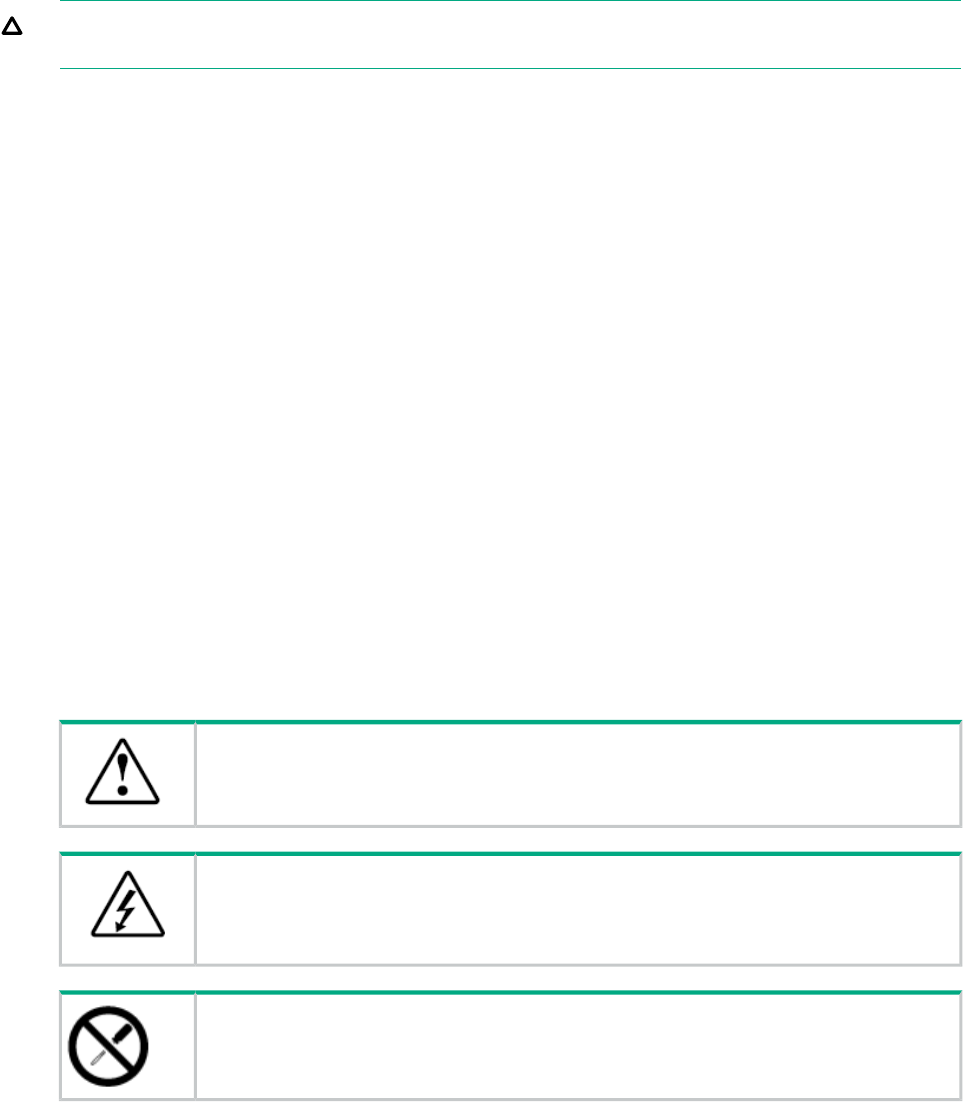
1 Safety precautions
Retain and follow all product safety and operating instructions. Always refer to the documentation
(printed or electronic) supplied with your product. If there is a conflict between this document and
the product documentation, the product documentation takes precedence. Observe all warnings
on the product and in the operating instructions to reduce the risk of bodily injury, electric shock,
fire, and damage to the equipment.
General precautions
CAUTION: For Class A products only:The installation and maintenance of products must
be carried out by qualified personnel.
If the product sustains damage requiring service, disconnect the product from all power sources
and refer servicing to aHewlett Packard Enterprise authorized service provider. Examples of
damage requiring service include:
•The power cord, extension cord, or plug has been damaged.
•Liquid has been spilled on the product or an object has fallen into the product.
•The product has been exposed to rain or water.
•The product has been dropped or damaged.
•The product does not operate normally when you follow the operating instructions.
To reduce the risk of personal injury or damage to the product:
•Place the product away from radiators, heat registers, stoves, amplifiers, or other products
that produce heat.
•Never use the product in awet location.
•Avoid inserting foreign objects through openings in the product.
•Move products with casters carefully. Avoid quick stops and uneven surfaces.
•Turn down the volume before using headphones or other audio devices.
Symbols on equipment
The following symbols may be placed on equipment to indicate the presence of potentially
hazardous conditions:
This symbol in conjunction with any of the following symbols indicates the presence of apotential
hazard. The potential for injury exists if warnings are not observed. Consult your documentation
for specific details.
This symbol indicates the presence of hazardous energy circuits or electric shock hazards. Refer
all servicing to qualified personnel.
WARNING: To reduce the risk of injury from electric shock hazards, do not open this enclosure.
Refer all maintenance, upgrades, and servicing to qualified personnel.
This symbol indicates the presence of electric shock hazards. The area contains no user or
field-serviceable parts. Do not open for any reason.
WARNING: To reduce risk of injury from electric shock hazards, do not open this enclosure.
General precautions 5
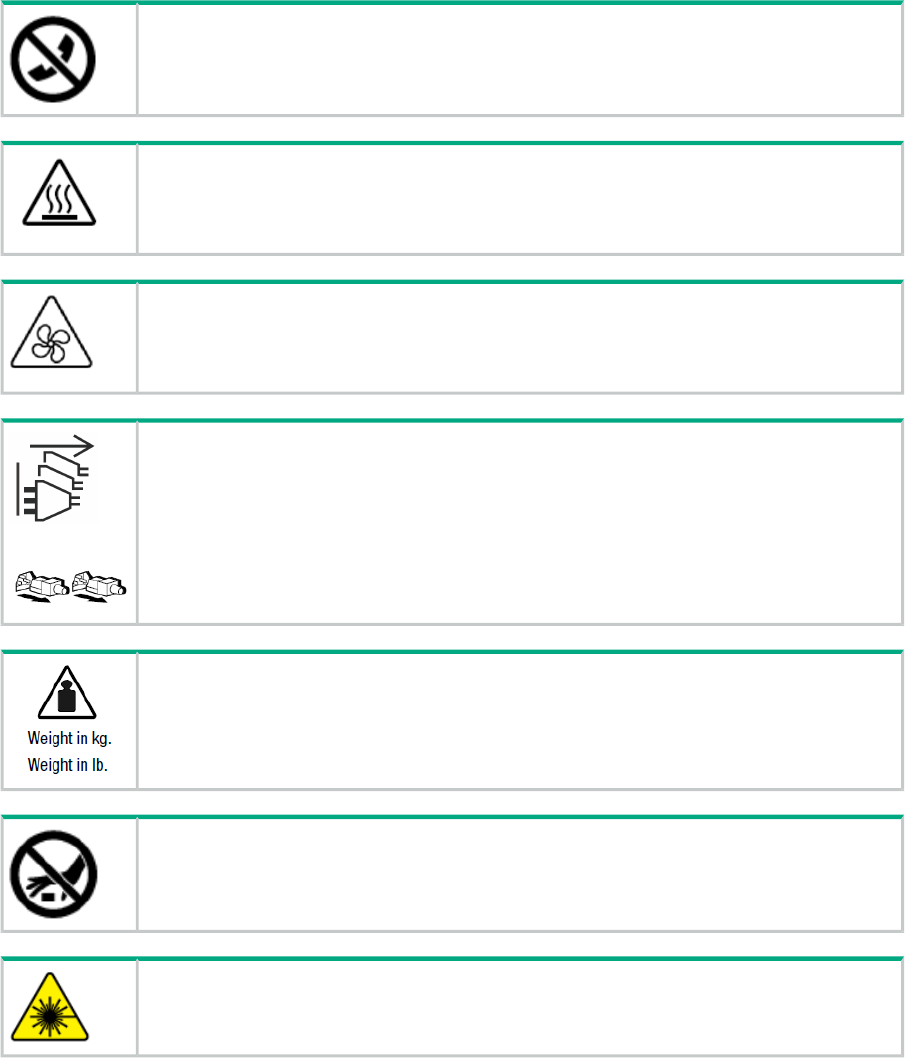
This symbol on an RJ-45 receptacle indicates a Network Interface Connection.
WARNING: To reduce risk of electric shock, fire, or damage to the equipment, do not plug telephone
or telecommunications connectors into this receptacle.
This symbol indicates the presence of ahot surface or hot component. If this surface is contacted,
the potential for injury exists.
WARNING: To reduce the risk of injury from a hot component, allow the surface to cool before
touching.
This symbol indicates the presence of a moving fan blade. If the spinning blades are contacted,
the potential for injury exists.
WARNING: Hazardous moving parts. Keep away from moving fan blades. To reduce the risk of
injury from a hot component, allow the surface to cool before touching.
These symbols on power supplies or systems indicate that the equipment is supplied by multiple
sources of power.
OR
WARNING: To reduce the risk of injury from electric shock, remove all power cords to completely
disconnect power from the system.
This symbol indicates that the component exceeds the recommended weight for one individual to
handle safely.
WARNING: To reduce the risk of personal injury or damage to the equipment, observe local
occupational health and safety requirements and guidelines for manual material handling.
A discharge of static electricity from a finger or other conductor may damage system boards or
other static-sensitive devices. To prevent damage, observe antistatic precautions.
This symbol indicates the presence of a laser device in the product that may exceed Class 1 limits.
Refer to the product documentation for more information.
Precautions for maintaining and servicing products
To reduce the risk of electric shock or damage to the equipment when installing, maintaining, or
servicing products, observe the following precautions:
•Some products contain power supplies that are capable of producing hazardous energy
levels. Refer to the documentation included with your product to determine whether it contains
these power supplies. The installation of internal options and routine maintenance and
service of this product should be performed by individuals who are knowledgeable about
the procedures, precautions, and hazards associated with equipment containing hazardous
energy levels.
•Allow the product to cool before removing covers and touching internal components.
6 Safety precautions
•Do not use conductive tools that could bridge live parts.
•Remove all watches, rings, or loose jewelry when working in hot-plug areas of an energized
server, storage, networking, or rack product.
•Do not attempt to defeat safety interlocks (where provided).
•Some products have covers or doors to access hot-plug components and may allow access
to hazardous energy circuits or moving fans.
◦The doors should remain locked during normal operation.
OR
◦The server, storage, networking, or rack product should be installed in a controlled
access location where only qualified personnel have access.
•Power down the equipment and disconnect all power cords before removing any access
covers for non-hot-plug areas.
•Do not replace non-hot-plug components while power is applied to the product. First, shut
down the product and disconnect all power cords.
•Do not exceed the level of repair specified in the procedures in the product documentation.
All troubleshooting and repair procedures are detailed to allow only subassembly or
module-level repair. Because of the complexity of the individual boards and subassemblies,
do not attempt to make repairs at the component level or to make modifications to any printed
wiring board. Improper repairs can create a safety hazard.
•For floor-standing products, install and extend bottom stabilizers before installing options
and boards.
•Verify that the AC power supply branch circuit that provides power to the rack is not
overloaded. This will reduce the risk of personal injury, fire, or damage to the equipment.
The total rack load should not exceed 80 percent of the branch circuit rating. Consult the
electrical authority having jurisdiction over your facility wiring and installation requirements.
Precautions for power products
Power cords
To reduce the risk of electric shock or damage to the equipment:
•Use an approved power cord. If you have questions about the type of power cord to use,
contact your Hewlett Packard Enterprise authorized service provider.
•If you have not been provided with apower cord for your product or for any AC-powered
option intended for your product, purchase a power cord that is approved for use in your
country.
•You must use a power cord rated for your product and for the voltage and current marked
on the electrical ratings label of the product. The voltage and current rating of the cord must
be greater than the voltage and current rating marked on the product.
•Do not place objects on AC power cords or cables. Arrange them so that no one may
accidentally step on or trip over them.
•Do not pull on a cord or cable. When unplugging from the electrical outlet, grasp the cord
by the plug.
•Make sure that the total ampere rating of all products plugged into an extension cord or
power strip does not exceed 80 percent of the ampere ratings limit for the extension cord or
power strip.
Precautions for power products 7
•Do not disable the power cord grounding plug. The grounding plug is an important safety
feature.
•Plug the power cord into a grounded (earthed) electrical outlet that is easily accessible at
all times.
Power supplies
Hot-plug power supplies are not designed to be removed or installed with AC power connected
to the power supply. To reduce the risk of electric shock or damage to the equipment when
handling hot-plug power supplies:
•Install the power supply before connecting the power cord to the power supply.
•Unplug the power cord before removing the power supply from the product.
•If the system has multiple sources of power, you must unplug all AC power cords from the
power supplies to completely disconnect power from the system.
•DC input power supplies do not connect directly to external bulk-level power systems
(48/60Vdc battery power). They must be connected to a local power distribution unit (PDU)
that provides a dedicated output with suitable overcurrent protection for each power
supply. The overcurrent protection (circuit breaker/pluggable fuse module) must be sized
according to the input rating of each power supply. Refer to the documentation provided
with the DC-powered system.
Verify that the external power source connected to your product matches the type of power source
indicated on the electrical ratings label. If you are not sure of the type of power source required,
consult your Hewlett Packard Enterprise authorized service provider or local power company.
Uninterruptible power supply (UPS) products
•To reduce the risk of electric shock and/or equipment damage when installing or servicing
UPS products:
◦The installation of options and routine maintenance and service of UPS products must
be performed by trained service technicians who are knowledgeable about the
procedures, precautions, and hazards associated with AC power products.
◦Hardwired UPS products require adirect connection to an AC branch circuit (AC mains).
Connection should only be performed in accordance with National Electrical Code
(NFPA70) Article 310 in North America or the equivalent local and national wiring
regulations.
◦Use a Lockout/Tagout procedure to isolate hardwired UPS products from AC power
before servicing the product or replacing a non-hot-plug component.
◦Do not operate a UPS that is disconnected from AC power. Use the TEST/ALARM
RESET button to test the batteries. Disconnect all protected loads before disconnecting
the UPS from AC power.
◦Pluggable UPS products must be disconnected and unplugged from AC power before
servicing the product or replacing a non-hot-plug component.
◦Do not overload the output of the UPS. The total connected load should not exceed the
rated output.
◦To reduce the risk of electric shock due to high leakage currents, ensure that there is
a reliable grounded (earthed) connection before connecting power distribution products
to AC power.
If a large number of products will be connected to a single UPS, it may be necessary
to conduct an evaluation of the installation to verify the total amount of leakage current.
8 Safety precautions
The total combined leakage current should not exceed 5 percent of the input current
for the UPS and associated load.
◦For rack installations, do not exceed the maximum number of UPS products in any
single equipment rack.
◦For rack installations, install the UPS only at the bottom of a rack.
•To reduce the risk of personal injury or damage to equipment when installing a Remote
Emergency Power Off (REPO) port:
◦The REPO port must be wired by a licensed electrician.
◦Verify that the main AC power disconnect device for the UPS is locked and/or tagged
in the OFF position before wiring the REPO port.
◦In North America, the REPO circuit must comply with the NEC (NFPA 70, Article 725)
for a Class 2 circuit. In other geographical regions or countries, the REPO port wiring
must comply with the national and local standards in the area in which the product is
installed.
•To reduce the risk of personal injury from electric shock or damage to equipment when
installing or servicing batteries:
◦Make sure that only trained service personnel handle or connect the batteries.
◦Remove watches, rings, or other metal objects prior to working with the equipment.
◦Use tools with insulated handles.
◦On products with remote external batteries, do not attempt to replace batteries unless
all battery circuit breakers are in the OFF (down) position. These are hazardous voltage
batteries.
•This product may contain sealed lead-acid or lithium-ion batteries. To reduce the risk of fire
or chemical burns:
◦Do not attempt to recharge batteries after they have been removed from the equipment.
◦Do not disassemble, crush, or puncture the batteries.
◦Do not short the external contacts of the batteries.
◦Do not immerse the batteries in water.
◦Do not expose the batteries to temperatures higher than 60°C or dispose of in fire.
◦Use only the Hewlett Packard Enterprise spare battery designated for this equipment.
Power distribution units (PDUs)
To reduce the risk of electric shock and/or equipment damage when installing or servicing PDUs:
•The installation and routine maintenance and service of PDUs must be performed by trained
service technicians who are knowledgeable about the procedures, precautions, and hazards
associated with AC power products.
•Hardwired PDUs require a direct connection to an AC branch circuit (AC mains). Connection
should only be performed in accordance with National Electrical Code (NFPA70 Article 310)
in North America, or in other regions or countries, in accordance with the equivalent local
and national wiring regulations.
Precautions for power products 9
•A reliable grounded (earthed) connection should be checked before connecting PDUs.
•Use a Lockout/Tagout procedure to isolate hardwired PDUs from AC power before servicing
or replacing the product.
•Pluggable PDUs must be disconnected from the product and unplugged from the AC electrical
outlet before servicing or replacing the product.
•Permanently connected PDUs must be disconnected from the product and the external
power source before servicing or replacing the product.
•Do not overload the output of PDUs. The total connected load should not exceed rated input
power.
•To reduce the risk of electric shock due to high leakage currents, ensure that there is a
reliable grounded (earthed) connection before connecting power distribution products to AC
power.
If a large number of products will be connected to a single PDU, it may be necessary to
conduct an evaluation of the installation to verify the total amount of leakage current. The
total combined leakage current should not exceed 5 percent of the input current for the PDU
and associated load.
Grounding
Depending on the product model, your product will be classified either as a safety Class I or
safety Class II-compliant device. Class I devices require a connection to earth ground (3-terminal
plug); Class II devices incorporate a 2-terminal plug.
•Class I: There must be an uninterruptible safety earth ground from the main power source
to the product's power cord or supplied power cord set. Whenever it is likely that the protection
has been impaired, disconnect the power cord until the ground has been restored.
•Class II:Safety Class II-compliant devices include supplemental insulation to protect against
electric shock, and do not require a connection to earth ground.
For LAN connections:
•If your LAN covers an area served by more than one power distribution system, be sure
their safety grounds are securely interconnected.
•LAN cables may occasionally be subject to hazardous transient voltages (such as lightning
or disturbances in the electrical utilities power grid). Handle exposed metal components of
the network with caution.
•This product and all interconnected equipment must be installed indoors within the same
building, including all associated LAN connections as described by Environment A of the
IEEE 802.3af standard.
Earth leakage current
To reduce the risk of electric shock due to high leakage currents, ensure that there is a reliable
grounded (earthed) connection before connecting power distribution products to AC power.
Observe the following limits when connecting the product to AC power distribution devices:
•For UPS products and PDUs that have attached AC power cords or are directly wired to the
building power,the total combined leakage current should not exceed 5 percent of the rated
input current for the device.
•For UPS products and PDUs that have detachable AC power cords, the total combined
leakage current should not exceed 3.5mA.
10 Safety precautions

Electrostatic discharge (ESD)
When handling any electronic component or assembly (such as a PCI card or memory DIMM),
you must observe the following antistatic precautions to prevent damage. An ESD kit (Hewlett
Packard Enterprise P/N A3024-80004) is available (or supplied with memory additions). This kit
contains one wrist strap, one conductive sheet, and one antistatic foam pad.
•Always disconnect power from the server and wear a grounded wrist strap when working
around the server.
•Always wear a grounded wrist strap when handling printed circuit boards.
•Treat all assemblies, components, and interface connections as static sensitive.
•Avoid working in carpeted areas and keep body movement to a minimum while removing
or installing boards to minimize buildup of static charge.
Voltage selection
•On products that have voltage select switches, make sure that the switch is set for the type
of voltage you use (115 VAC or 230 VAC).
•Do not attempt to power the product with voltage converter kits sold for appliances.
Batteries
WARNING! Some Hewlett Packard Enterprise products may contain internal replaceable
battery cells or battery packs. There is risk of fire, burns, or explosion if the battery pack is not
handled properly. To reduce the risk of personal injury:
•Do not attempt to recharge the battery.
•Do not disassemble, crush, puncture, short external contacts, or dispose of the battery in
fire or water.
•Replace only with the Hewlett Packard Enterprise spare battery designated for this product.
Dispose of used batteries according to the manufacturer's instructions and local disposal
requirements.
•For battery holders (for example, coin cells), observe the correct polarity when changing the
battery/cell. There is adanger of explosion if the battery is installed incorrectly.
Precautions for power products 11
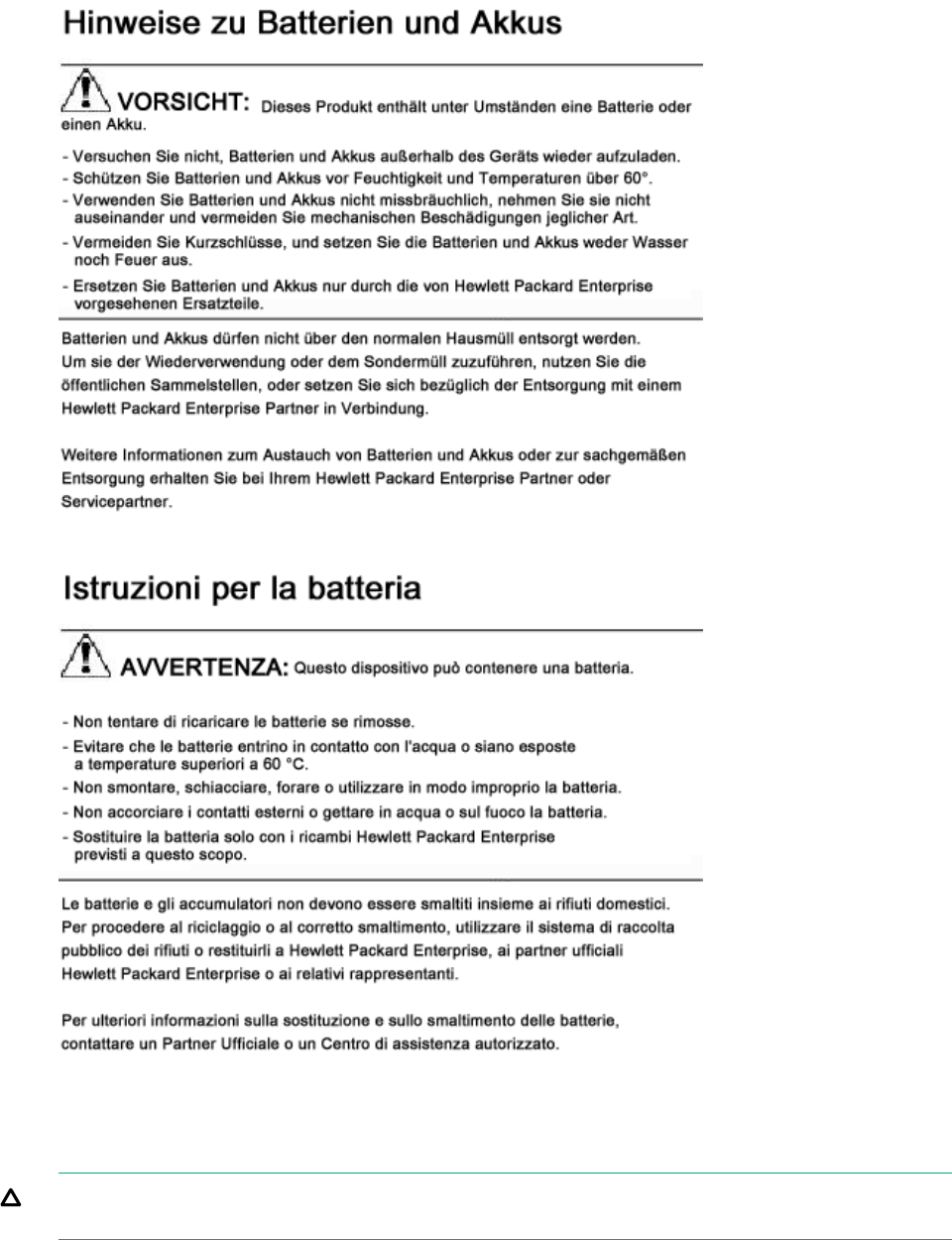
Fuse replacement
CAUTION: For continued protection against risk of fire, replace fuses only with fuses of the
same type and the same rating. Disconnect power before changing fuses.
12 Safety precautions

Precautions for products installed in racks and cabinets
Materials handling
To reduce the risk of personal injury or damage to the equipment:
•Observe local occupational health and safety requirements and guidelines for handling
materials.
•Obtain assistance to lift and stabilize the product during installation or removal.
•Remove all pluggable power supplies and modules to reduce the weight of the product.
•Be careful when pressing the rail release latches and sliding the product into the rack. The
slide rails could pinch your fingertips.
Rack stability
To reduce the risk of personal injury or damage to the equipment, the rack must be secured
adequately to prevent it from becoming unstable and/or falling over.
•Extend the leveling jacks to the floor.
•Ensure that the full weight of the rack rests on the leveling jacks.
•Install stabilizing feet on the rack.
•In a multiple-rack installation, fasten the racks together securely.
•Extend only one rack component at a time. Racks can become unstable if more than one
component is extended.
•Load the rack from the bottom up, starting with the heaviest component.
•Ensure that the component is properly mated with the rails, or the rails may be unstable.
•Do not attempt to move afully loaded rack. Remove components from the rack before moving
it.
•Do not attempt to move a rack on an incline that is greater than 10 degrees from horizontal.
Cabinet safety
WARNING! Cabinets are heavy even when empty. Exercise caution when moving cabinets
whether equipment is installed in the cabinet or not. Avoid rolling cabinets on rough or uneven
surfaces or inclines greater than 10 degrees. Unloading cabinets from the pallet and movement
of cabinets should be performed by at least two people.
Slideable products are not to be extended from the cabinet while the equipment is on the shipping
pallet. The cabinet must be unloaded from the pallet and all anti-tip devices properly installed
prior to extending any slideable product.
Once installed, all anti-tip devices must remain in place to maintain stability. Only one slideable
product must be extended at a time.
Failure to follow these precautions can result in damage to equipment or injury to personnel.
Precautions for modems, telecommunications, or LAN options
To reduce the risk of exposure to shock from telephone ringing voltages:
•Do not connect or use a modem or telephone (other than a cordless type) during a lightning
storm.
•Do not use a telephone line to report a gas leak while you are in the vicinity of the leak.
•Do not connect or use a modem or telephone cable in awet location.
Precautions for products installed in racks and cabinets 13
•Disconnect the modem cable from the wall socket before opening a product enclosure,
touching or installing internal components, or touching an uninsulated modem cable or jack.
•Do not plug telecommunications or telephone connectors into the NIC receptacles.
14 Safety precautions
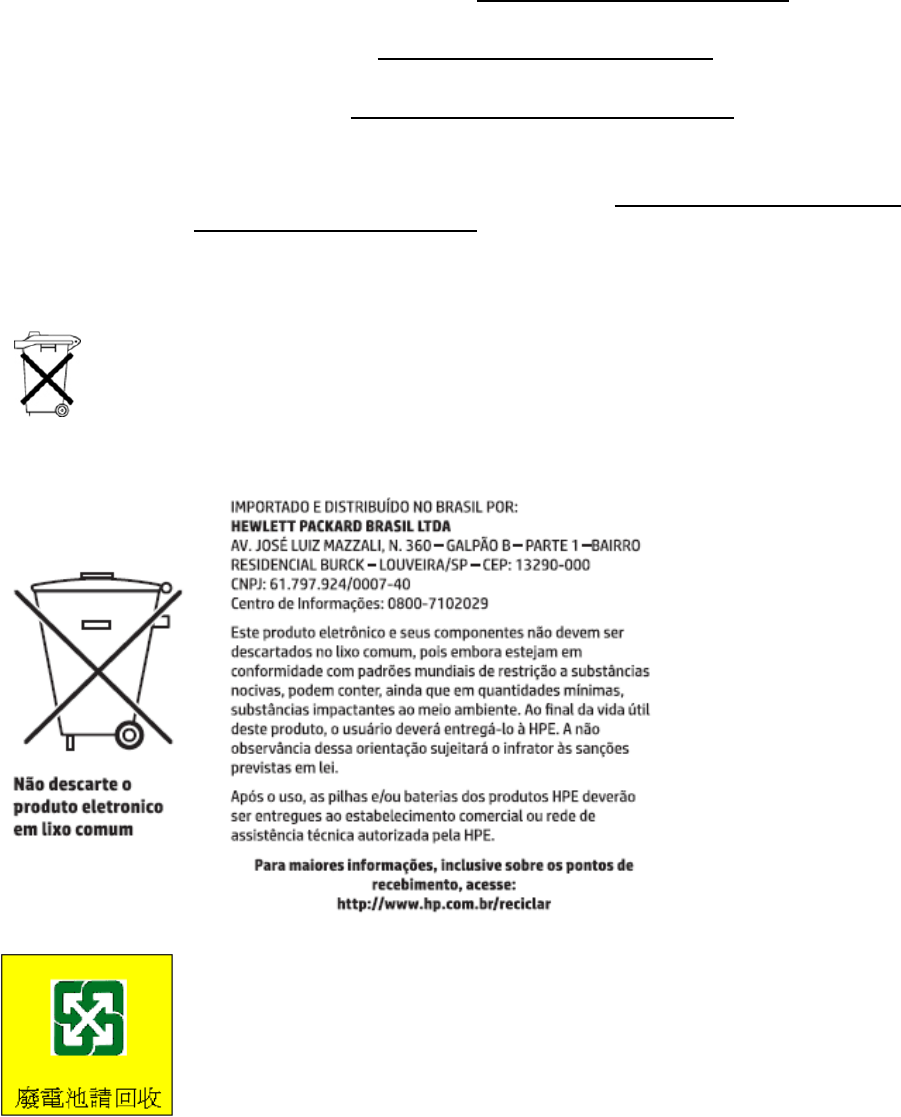
2 Environmental notices
Hewlett Packard Enterprise is committed to providing our customers with information about the
chemical substances in our products as needed to comply with legal requirements such as
REACH (Regulation EC No 1907/2006 of the European Parliament and the Council). A chemical
information report for this product can be found at http://www.hpe.com/info/reach.
For Hewlett Packard Enterprise product environmental and safety information and compliance
data, including RoHS and REACH, see http://www.hpe.com/info/ecodata.
For Hewlett Packard Enterprise environmental information, including company programs, product
recycling, and energy efficiency, see http://www.hpe.com/info/environment.
Waste Electrical and Electronic Equipment (WEEE) Directive
For details about the European Union (EU) WEEE Directive, see WEEE Information for Users
or go to the website http://www.hpe.com/recycle.
Battery replacement notices
Batteries, battery packs, and accumulators should not be disposed of together with the general
household waste. To forward them to recycling or proper disposal, use the public collection system or
return them to Hewlett Packard Enterprise, an authorized Hewlett Packard Enterprise Partner, or their
agents.
For more information about battery replacement or proper disposal, contact an authorized reseller or
an authorized service provider.
Waste Electrical and Electronic Equipment (WEEE) Directive 15
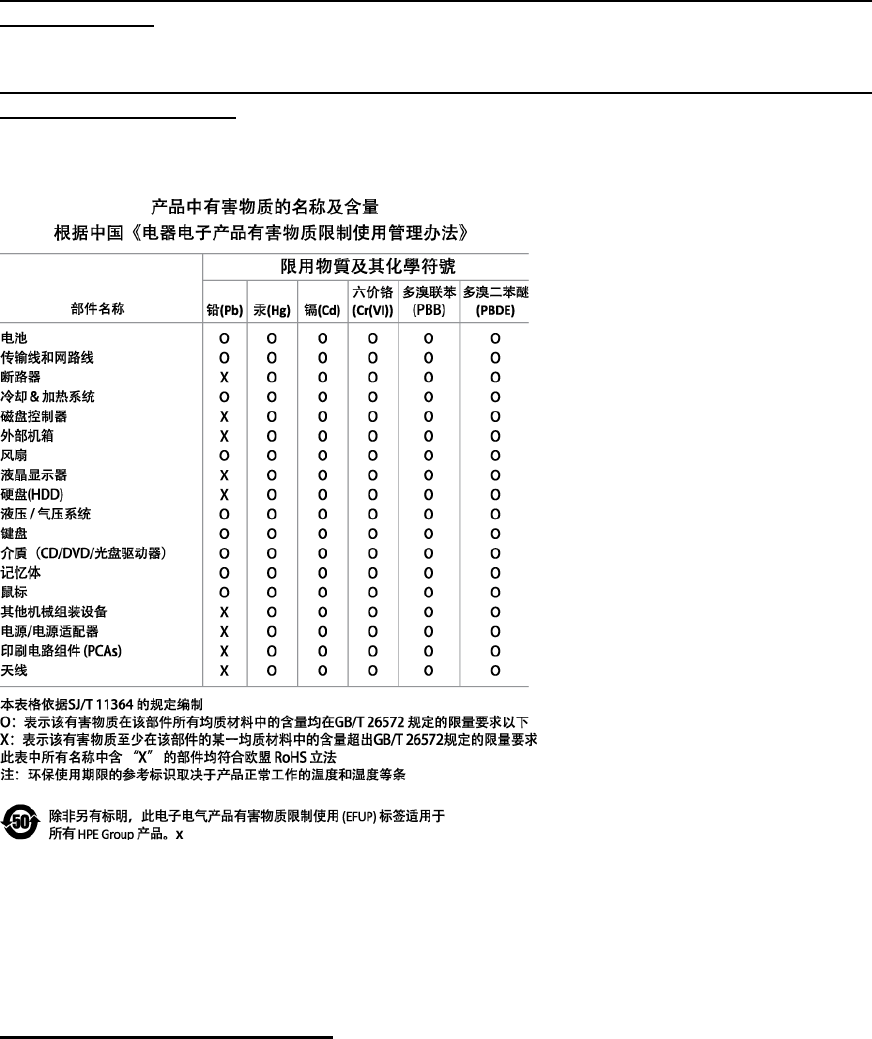
RoHS material content declarations
China RoHS material content declaration
Chinese version:
http://www8.hp.com/us/en/hpe/hp-information/livingprogress/environmentalprogress/
chinarohs.html
English version:
http://www8.hp.com/us/en/hpe/hp-information/livingprogress/environmentalprogress/
chinarohs-english.html
China RoHS Hazardous Substances table
India RoHS material content declaration
This product complies with the “India E-waste (Management) Rules, 2016” and prohibits use of
lead, mercury, hexavalent chromium, polybrominated biphenyls or polybrominated diphenyl
ethers in concentrations exceeding 0.1 weight %and 0.01 weight %for cadmium, except for the
exemptions set in Schedule II of the Rule.
India RoHS quarterly declaration
16 Environmental notices
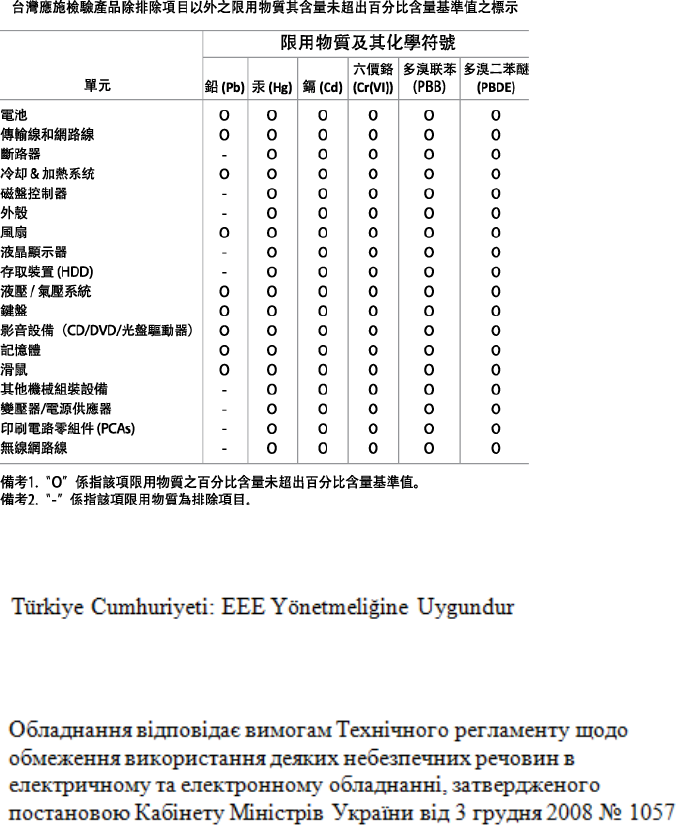
Taiwan RoHS Hazardous Substances table
Turkey RoHS material content declaration
Ukraine RoHS material content declaration
RoHS material content declarations 17

Perchlorate material — Special handling may apply
Perchlorate material -special handling may apply.See http://www.dtsc.ca.gov/hazardouswaste/
perchlorate/.
This product’sreal-time clock battery or coin cell battery may contain perchlorate and may require
special handling when recycled or disposed of in California.
18 Environmental notices

European Union Commission Regulation 1275/2008
The power data for affected products—including the power consumption of the product in
networked standby if all wired network ports are connected and all wireless network ports are
activated—is provided in section P14, “Additional information,” of the product IT ECO Declaration
available at https://www.hpe.com/global/livingprogress/environmentalprogress/productdata/
iteconetworking_hpe.html.
European Union Commission Regulation 1275/2008 19

3 Regulatory compliance notices
Regulatory compliance identification numbers
For the purpose of regulatory compliance certifications and identification, this product has been
assigned a unique regulatory model number. The regulatory model number can be found on the
product nameplate label, along with all required approval markings and information. When
requesting compliance information for this product, always refer to this regulatory model number.
The regulatory model number is not the marketing name or model number of the product.
Federal Communications Commission notice
This device complies with Part 15 of the FCC Rules. Operation is subject to the following two
conditions: (1) this device may not cause harmful interference, and (2) this device must accept
any interference received, including interference that may cause undesired operation.
For questions regarding this product, go to the Hewlett Packard Enterprise Support Center
website:
http://www.hpe.com/support/hpesc
For questions regarding this FCC declaration, contact us by mail or telephone:
•Hewlett Packard Enterprise
3000 Hanover Street
Palo Alto, CA 94304 U.S.
•1-281-514-3333
To identify the product, refer to the part, series, or model number found on the product.
Part 15 of the Federal Communications Commission (FCC) Rules and Regulations has established
Radio Frequency (RF) emission limits to provide an interference-free radio frequency spectrum.
Many electronic devices, including computers, generate RF energy incidental to their intended
function and are, therefore, covered by these rules. These rules place computers and related
peripheral devices into two classes, A and B, depending upon their intended installation. Class
A devices are those that may reasonably be expected to be installed in a business or commercial
environment. Class B devices are those that may reasonably be expected to be installed in a
residential environment (for example, personal computers). The FCC requires devices in both
classes to bear alabel indicating the interference potential of the device as well as additional
operating instructions for the user.
FCC rating label
The FCC rating label on the device shows the classification (A or B) of the equipment. Class B
devices have an FCC logo or ID on the label. Class A devices do not have an FCC logo or ID
on the label. After you determine the class of the device, refer to the corresponding statement.
Class A equipment
This equipment has been tested and found to comply with the limits for a Class A digital device,
pursuant to Part 15 of the FCC rules. These limits are designed to provide reasonable protection
against harmful interference when the equipment is operated in a commercial environment. This
equipment generates, uses, and can radiate radio frequency energy and, if not installed and
used in accordance with the instructions, may cause harmful interference to radio communications.
Operation of this equipment in a residential area is likely to cause harmful interference, in which
case the user will be required to correct the interference at personal expense.
20 Regulatory compliance notices
Class B equipment
This equipment has been tested and found to comply with the limits for a Class B digital device,
pursuant to Part 15 of the FCC Rules. These limits are designed to provide reasonable protection
against harmful interference in a residential installation. This equipment generates, uses, and
can radiate radio frequency energy and, if not installed and used in accordance with the
instructions, may cause harmful interference to radio communications. However, there is no
guarantee that interference will not occur in a particular installation. If this equipment does cause
harmful interference to radio or television reception, which can be determined by turning the
equipment offand on, the user is encouraged to try to correct the interference by one or more
of the following measures:
•Reorient or relocate the receiving antenna.
•Increase the separation between the equipment and receiver.
•Connect the equipment into an outlet on a circuit that is different from that to which the
receiver is connected.
•Consult the dealer or an experienced radio or television technician for help.
Modification
The FCC requires the user to be notified that any changes or modifications made to this device
that are not expressly approved by Hewlett Packard Enterprise may void the user's authority to
operate the equipment.
Cables
Connections to this device must be made with shielded cables (except for RJ-45 cables) with
metallic RFI/EMI connector hoods in order to maintain compliance with FCC Rules and
Regulations.
Global notice for Class A equipment
Operation of this equipment in a residential environment could cause radio interference.
Notices for Canada (Avis Canadien)
Class A equipment
This Class A digital apparatus meets all requirements of the Canadian Interference-Causing
Equipment Regulations. CAN ICES-3(A)/NMB-3(A)
Cet appareil numérique de la class A respecte toutes les exigences du Règlement sur le matériel
brouilleur du Canada.
Class B equipment
This Class B digital apparatus meets all requirements of the Canadian Interference-Causing
Equipment Regulations. CAN ICES-3(B)/NMB-3(B)
Cet appareil numérique de la class B respecte toutes les exigences du Règlement sur le matériel
brouilleur du Canada.
Global notice for Class A equipment 21
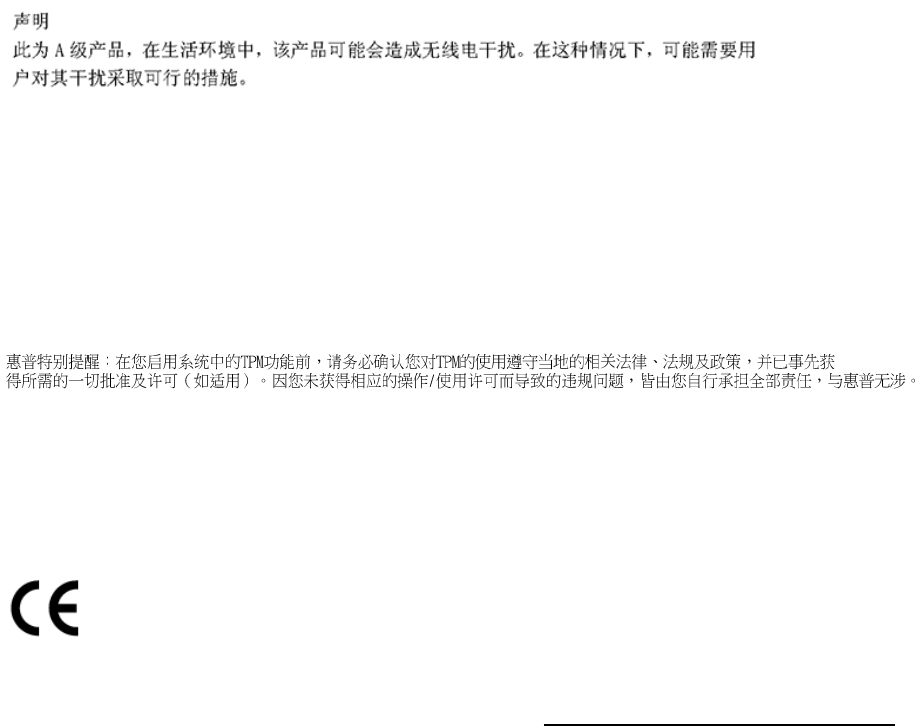
Notices for China
Class A equipment
Trusted Platform Module (TPM) – China Import Restrictions
HEWLETT PACKARD ENTERPRISE SPECIAL REMINDER: Before enabling TPM functionality
on this system, you must ensure that your intended use of TPM complies with relevant local laws,
regulations and policies, and approvals or licenses must be obtained if applicable.
For any compliance issues arising from your operation/usage of TPM which violates the above
mentioned requirement, you shall bear all the liabilities wholly and solely. Hewlett Packard
Enterprise will not be responsible for any related liabilities.
Notices for European Union
European Union Regulatory Notice
Products bearing the CE marking comply with applicable EU Directives:
Compliance with such directives is assessed using applicable European Harmonised Standards.
The Declaration of Conformity can be found at the website http://www.hpe.com/eu/certificates.
(Search with the product model name or its Regulatory Model Number (RMN), which may be
found on the regulatory label.)
The point of contact for regulatory matters is HPE, Postfach 0001, 1122 Wien, Austria.
Products with wireless functionality (EMF)
This product meets the provisions of the EU's Council recommendation 1999/519/EC on the
limitation of the exposure of the general public to electromagnetic fields (0 Hz to 300 GHz). This
product may incorporate a radio transmitting and receiving device. For products with wireless
functionality, a separation distance of 20 cm between the body of the user and the antenna
ensures that the RF exposure levels comply with the EU requirements.
Restrictions for product with wireless functionality
For products with 5GHz WLAN functionality: when operating in the frequency band 5150 to 5350
MHz, this product is restricted to indoor use only.
22 Regulatory compliance notices
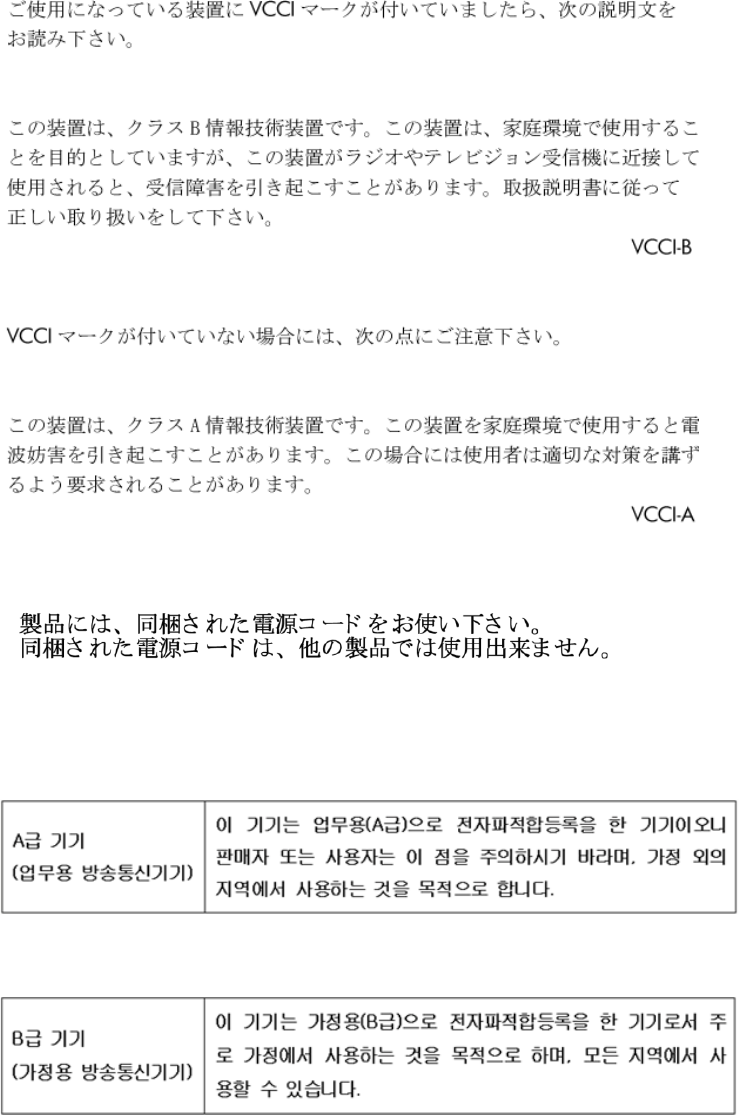
Notices for Japan
VCCI notice
Power cord statement
Notices for Korea
Class A equipment
Class B equipment
Notices for Japan 23
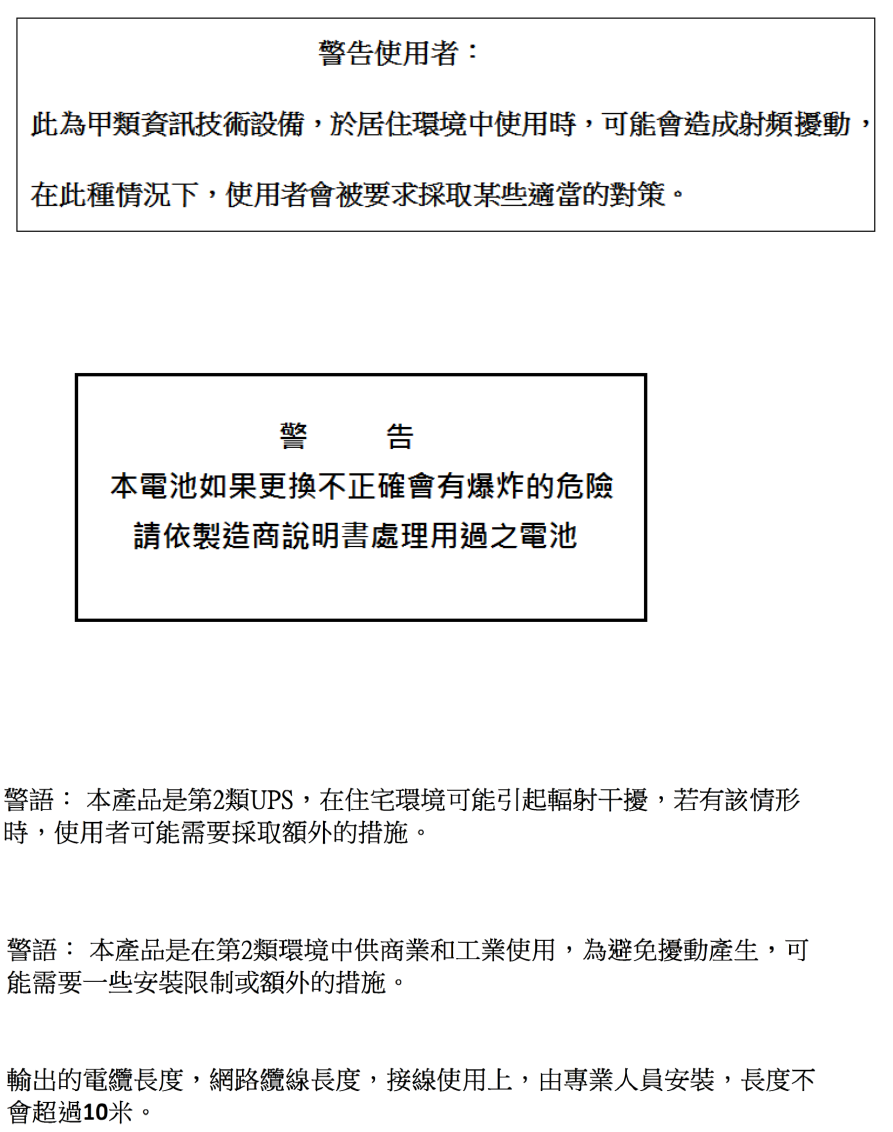
Notices for Taiwan
BSMI notices
Class A EMI warning message
Battery replacement notice
UPS (less than 16A output current)
UPS (greater than 16A output current)
24 Regulatory compliance notices
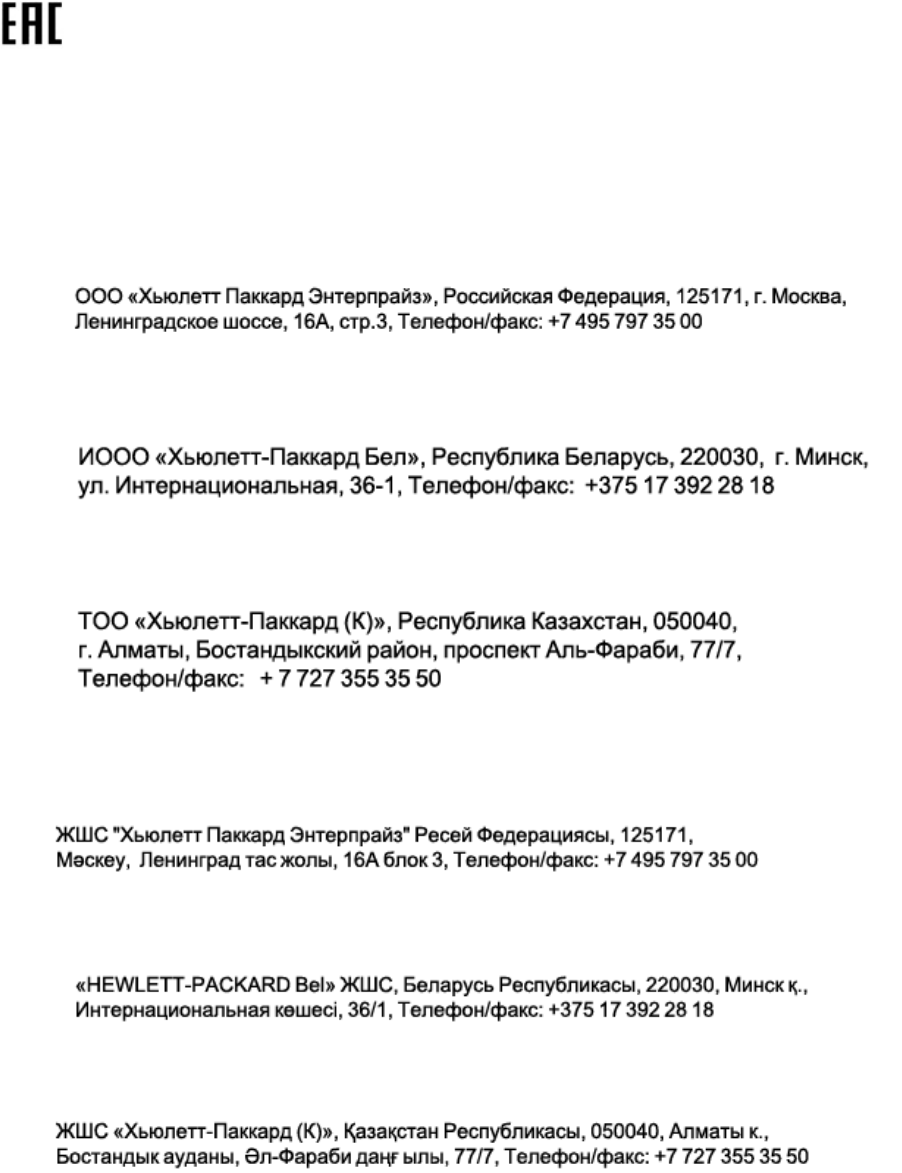
Belarus Kazakhstan Russia marking
Manufacturer and Local Representative Information
Manufacturer information:
•Hewlett Packard Enterprise Company, 3000 Hanover Street, Palo Alto, CA 94304 U.S.
Local representative information Russian:
•Russia:
•Belarus:
•Kazakhstan:
Local representative information Kazakh:
•Russia:
•Belarus:
•Kazakhstan:
Manufacturing date:
The manufacturing date is defined by the serial number.
CCSYWWZZZZ (serial number format for this product)
Belarus Kazakhstan Russia marking 25
Valid date formats include:
•YWW, where Y indicates the year counting from within each new decade, with 2000 as the
starting point; for example, 238: 2for 2002 and 38 for the week of September 9. In addition,
2010 is indicated by 0, 2011by 1, 2012 by 2, 2013 by 3, and so forth.
•YYWW, where YY indicates the year, using a base year of 2000; for example, 0238: 02 for
2002 and 38 for the week of September 9.
26 Regulatory compliance notices
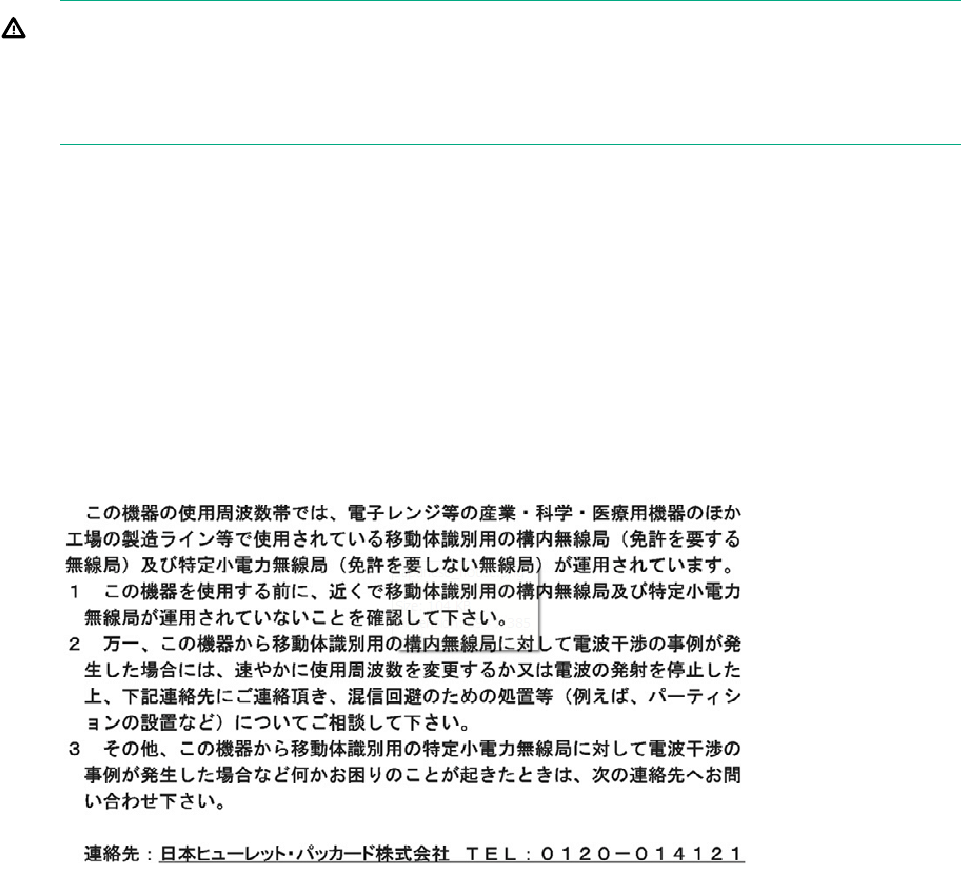
Wireless devices
In some environments, the use of wireless devices might be restricted. Such restrictions might
apply on airplanes, in hospitals, near explosives, or in other hazardous locations. Before you
turn on this product, be sure that you understand local policies and have proper authorization.
WARNING! Exposure to Radio Frequency Radiation:The radiated output power of this
device is below the FCC radio exposure limits. Nevertheless, the device should be used in such
a manner that the potential for human contact during normal operation is minimized. To avoid
the possibility of exceeding the FCC radio frequency exposure limits, human proximity to the
antennas should not be less than 20 cm (8 inches) during normal operation.
Brazilian notice
Este equipamento opera em caráter secundário, isto é, não tem direito a proteção contra
interferência prejudicial, mesmo de estações do mesmo tipo, enão pode causar interferência a
sistemas operando em caráter primário.
Canadian notice
Wireless operation is subject to two conditions. The first is that the wireless device may not cause
interference. The second is that the wireless device must accept any interference, including
interference that may cause undesired operation of the device.
Japanese notice
Mexican notice
La operación de este equipo está sujeta a las siguientes dos condiciones: (1) es posible que
este equipo o dispositivo no cause interferencia perjudicial y (2) este equipo o dispositivo debe
aceptar cualquier interferencia, incluyendo la que pueda causar su operación no deseada.
Wireless devices 27
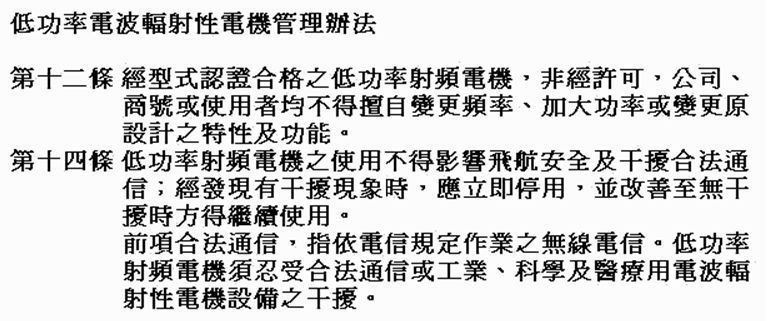
Taiwanese notice
28 Regulatory compliance notices
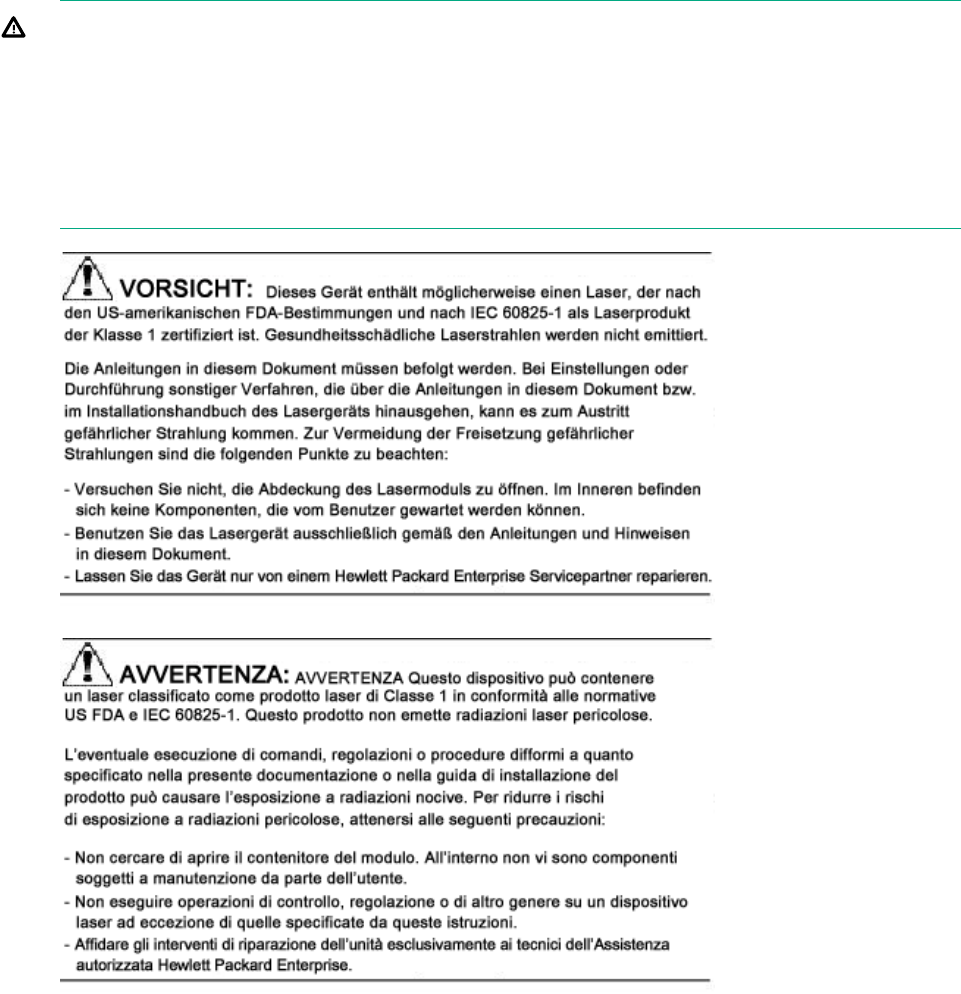
Laser compliance notices
This device may contain a laser that is classified as a Class 1 Laser Product in accordance with
U.S. FDA regulations and the IEC 60825-1. The product does not emit hazardous laser radiation.
Each laser product complies with 21 CFR 1040.10 and 1040.11 (except for deviations pursuant
to Laser Notice No. 50, dated May 27, 2001) and with IEC 60825-1.
WARNING! Use of controls or adjustments or performance of procedures other than those
specified herein or in the laser product's installation guide may result in hazardous radiation
exposure. To reduce the risk of exposure to hazardous radiation:
•Do not try to open the module enclosure. There are no user-serviceable components inside.
•Do not operate controls, make adjustments, or perform procedures to the laser device other
than those specified herein.
•Allow only Hewlett Packard Enterprise Authorized Service technicians to repair the unit.
Laser compliance notices 29
Index
B
batteries
replacement notices, 15
safety precautions, 9, 11
Belarus Kazakhstan Russia EAC marking, 25
BSMI notices, 24
C
cabinet safety, 13
CE compliance marking
European Union Regulatory Notice, 22
China import restrictions
Trusted Platform Module (TPM), 22
China RoHS Hazardous Substances table, 16
China RoHS material content declaration, 16
D
Declaration of Conformity
European Union Regulatory Notice, 22
E
EAC marking
Belarus Kazakhstan Russia, 25
earth leakage current, 10
electromagnetic interference (EMI)
cable connector hoods, 21
electrostatic discharge (ESD), 11
EMC compliance notices, 20
EMF (electromagnetic fields)
European Union Regulatory Notice, 22
environmental notices, 15
battery replacement and disposal, 15
European Union Commission Regulation 1275/2008,
19
perchlorate, 18
REACH, 15
RoHS, 15
WEEE, 15
equipment symbols, 5
ESD kit, 11
EuroAsian Economic Commission (EAC), 25
European Union Commission Regulation 1275/2008, 19
European Union Regulatory Notice
CE compliance marking, 22
Declaration of Conformity, 22
products with wireless functionality (EMF), 22
F
FCC notice, 20
FCC rating label, 20
Class A equipment, 20
Class B equipment, 21
fuse replacement, 12
G
grounding
earth leakage current, 10
ESD, 11
safety precautions, 10
L
laser compliance notices, 29
M
maintaining and servicing products
safety precautions, 6
materials handling
products installed in racks and cabinets, 13
modems
safety precautions, 13
P
perchlorate material
safety precautions, 18
power cords
safety precautions, 7
power distribution units (PDUs)
safety precautions, 9
power supplies
safety precautions, 8
products installed in racks and cabinets
materials handling, 13
safety precautions, 13
products with wireless functionality (EMF), 22
R
rack stability, 13
radio frequency (RF) emission limits
FCC notice, 20
radio frequency interference (RFI)
cable connector hoods, 21
REACH, 15
recycling notices, 15
regulatory compliance identification numbers, 20
regulatory compliance notices, 20
BSMI, 24
Canada (Avis Canadien), 21
China, 22
European Union, 22
FCC, 20
global notice for Class A equipment, 21
identification numbers, 20
Japan, 23
Korea, 23
laser notices, 29
recycling notices, 15
Taiwan, 24
WEEE Directive, 15
wireless devices, 27
regulatory information
Turkey RoHS material content declaration, 17
Ukraine RoHS material content declaration, 17
regulatory model number, 20
30 Index
Remote Emergency Power Off (REPO) port
safety precautions, 9
RoHS Hazardous Substances table
China, 16
Taiwan, 17
RoHS material content declarations
China, 16
S
safety precautions, 5
batteries, 9, 11
cabinets, 13
fuse replacement, 12
general, 5
grounding, 10
maintaining and servicing products, 6
modems, 13
modems, telecommunications, or LAN options, 13
PDUs, 9
power cords, 7
power products, 7
power supplies, 8
products installed in racks and cabinets, 13
REPO port, 9
telecommunications equipment, 13
UPS, 8
voltage selection, 11
substances
environmental notices, 15
perchlorate material, 18
RoHS material content declarations, 16
symbols on equipment, 5
T
Taiwan RoHS Hazardous Substances table, 17
telecommunications equipment
safety precautions, 13
Trusted Platform Module (TPM)
China import restrictions, 22
Turkey RoHS material content declaration, 17
U
Ukraine RoHS material content declaration, 17
UPS products
safety precautions, 8
V
VCCI notice, 23
voltage selection, 11
W
WEEE Directive, 15
wireless devices, 27
Brazilian notice, 27
Canadian notice, 27
electromagnetic fields (EMF), 22
Japanese notice, 27
Mexican notice, 27
Taiwanese notice, 28
31